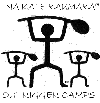
THE HANA HOU SERIES The Flip Side © 1999 Kawika Sands |

THE HANA HOU SERIES The Flip Side © 1999 Kawika Sands |
|
NOTE: Each club/coach/steersman has their own procedures on righting a
capsized outrigger. These are the procedures I teach my keiki:
In the old days, Hawaiians reviewed ho`olana [to float/righting] procedures with model canoes and knew a variety of ways to right a canoe including the use of ropes and nets. For them it was a matter of survival. Today it should be COMPULSORY to everyone who sets foot in an outrigger! You may use a model, a set of diagrams or better yet, a drill with the right prop. In actual conditions the REAL danger is panic/fear which usually comes from the unknown. Practice helps to mitigate this danger. Once dry-land training is done, you must now practice with an actual luma`i [capsize] (huli means "turn") and ho`olana in CALM water. After that, practice under actual conditions should be done. Consider also creating contingent plans in case something goes wrong. When the crew shoves-off, the STEERSMAN is responsible AND liable. The first responsibility of the steersman is the safety his crew, second is the safety canoe, the THIRD is the competent steering and navigation of his craft. Before leaving shore, the Steersman should check the canoe's hull, `iako, ama, lashings, and emergency equipment which includes: One PFD for each person aboard, signal flares (3 day/night type), a survival/emergency whistle, one extra paddle, light sticks and a VHF marine radio. The objection that it is "so much stuff" is NONSENSE! Apart from a tow rope, everything you need can be easily fitted into the average hip-bag! 1. ILIWAI [surface]: Everyone surfaces on the AMA side for protection and coordination purposes. Take a quick look aft for oncoming canoes and be prepared to submerge QUICKLY in case a hull or ama is headed your way! Everyone checks for their partner (1 and 2, 3 and 4, 5 and 6). If your partner has not surfaced, BEFORE going after him, let someone ELSE know before you go under. NOTE: If you must swim/duck under the canoe, remember to have at least one hand on the mo`o [rim] at all times to keep from hitting your head! If everyone is fine, the Steersman will shout and signal "GO!" 2. KULANA [position]: #1 swims to the forward manu watching for oncoming canoes and the entire team for any sign of concussion, injury, etc.. The Steersman swims forward collecting paddles and other gear (it helps to have something to tie the gear together with in your pocket especially if ALL the paddles have "T" grips). When he gets to the bow, he waits and watches with #1 until the outrigger has been righted. #2, #3, #4 and #5 take position along the hull/`iako.
(Assuming swells UNDER six feet) 4. KUPONO [upright]: #2, #3, #4 and #5 climb the `iako, grab the mo`o, go over the ka`ele [hull], slide down the muku [side opposite the ama] side of the hull and roll the outrigger over (three keiki or two teens or one adult are usually sufficient to do this). If this step is done fast/well enough, the pauma/ka wa`a phases may not be necessary. 5. PAUMA [to empty the canoe of water]: After getting the canoe right-side-up, #2, #3, #4, and #5 stand on the ama to force it down as the swell approaches. This turns and raises the canoe enough that it can be emptied of most of the water. At the right moment, #5 shouts "LAWA" [enough] so everyone stops and gets off the ama at the same time. 6. KA WA`A [bail]: While #1 continues to observe everything aft, #2, #3, #4, and #5 begin bailing. #6 swims aft along the ama side of the hull replacing equipment as he goes (Steersman or #1 might wait at the ama to prevent another luma`i). When enough water has been bailed, the Steersman orders the team aboard one at a time (since the water will be deepest in the canoe at the #4 or #5 seats, one or both might continue to bail after "paddles-up" is called. Usually #5). If the Steersman sees that it may be impossible for the crew to right the outrigger, he will call "LIFE JACKETS!" then signal for assistance.
(Assuming swells OVER six feet) 4a. KUPONO [upright]: Same as step 5 above. 5a. PAUMA [empty canoe of water]: As the swell lifts the bow, #5 shouts "ON!" everyone forces the aft down letting the water awash aft. When #5 shouts "LAWA!" everyone lets the canoe go. 6a. KA WA`A [bail]: Same as above. If the Steersman sees that it may be impossible for the crew to right the outrigger, he will call "LIFE JACKETS!" Then he will signal for assistance. In righting the outrigger, and following the above steps (from the time the ama slapped the water to the time it was righted), it took my keiki less than 12 seconds. There's no reason why adults shouldn't do it faster.
|

Last Modified: Saturday - 19991113.12:36 EST
Copyright © 1999 Kawika Sands
Produced online by HoloHolo Internet Publishing all rights reserved